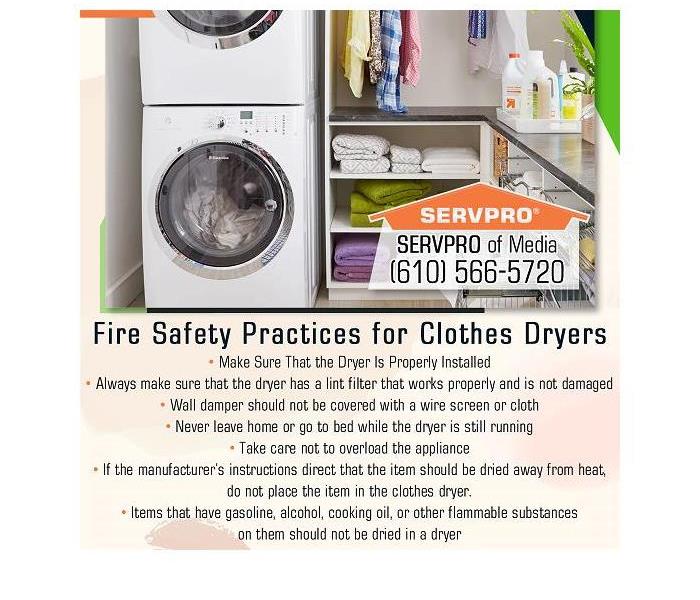How Homeowners Can Proactively Implement Fire Safety Practices for Clothes Dryers
10/19/2021 (Permalink)
Blog Summary: Failure to clean the clothes dryer is the leading cause of fires resulting from this home appliance. By proactively cleaning and maintaining the clothes dryer, the homeowner can minimize the potential for fire damage in the home.
In the aftermath of a fire damage disaster, homeowners often feel confused and devastated. They find themselves in need of a trusted restoration company to help them deal with the situation and guide them through the recovery process, which can be challenging and stressful. Many fire damage disasters are unexpected events that catch people completely by surprise; however, the proactive homeowner can take preventative measures in and around the house to reduce the likelihood of fires. One key area to implement fire safety practices is in the care and maintenance of clothes dryers.
Clothes Dryer Fire Statistics
According to the U.S. Fire Administration, “2,900 home clothes dryer fires are reported each year and cause an estimated 5 deaths, 100 injuries, and $35 million in property loss….More home clothes dryer fires occur in the fall and winter months, peaking in January.” One of the most revealing statistics reported by the U.S. Fire Administration is that 34% of residential clothes dryer fires are caused by a failure to clean the appliance. In fact, a failure to clean is the top cause of home dryer-related fires.
Make Sure That the Dryer Is Properly Installed
After purchasing a clothes dryer, hire a professional to install the appliance. New clothes dryer units come with instructions and user manuals, and homeowners should familiarize themselves with these documents in order to properly use and care for the machine.
How to Safely Use a Clothes Dryer
Always make sure that the dryer has a lint filter that works properly and is not damaged, blocked, or loosely attached. The dryer’s wall damper should not be covered with a wire screen or cloth, which could accumulate lint and clog the vent. Never leave home or go to bed while the dryer is still running; instead, wait for the load of clothes to finish drying.
When drying a load of clothes, take care not to overload the appliance. Certain materials should never be put through the clothes dryer. These materials include:
- Plastic
- Rubber
- Foam
- Glass fiber (unless specifically permitted in the manufacturer’s instructions)
If the manufacturer’s instructions direct that the item should be dried away from heat, do not place the item in the clothes dryer. Items that have gasoline, alcohol, cooking oil, or other flammable substances on them should not be dried in a dryer. To avoid fire damage, the homeowner should dry these items outside or in a room that has good ventilation and is away from sources of heat.
How to Clean a Clothes Dryer
Regular cleaning of the clothes dryer is essential to prevent the appliance from becoming a fire hazard. The lint filter should be emptied both before and after the laundry is dried. Remember to clean out lint build-up at the back of the dryer. Every six months, use a nylon brush to clean the filter; however, this procedure may need to be done more often if the filter is clogged. Every three months, lint should be removed from the vent pipe.
Professional dryer cleaning is a good service to invest in periodically. If loads of laundry are taking more time than usual to dry, the homeowner will want to call in a professional to clean the appliance.
How to Maintain a Clothes Dryer
The U.S. Fire Administration provides the following tips for clothes dryer maintenance: “Inspect the venting system behind the dryer to ensure it is not damaged or restricted. Put a covering on outside wall dampers to keep out rain, snow, and dirt. Make sure the outdoor vent covering opens when the dryer is on. Replace coiled-wire foil or plastic venting with rigid, non-ribbed metal duct. Have gas-powered dryers inspected every year by a professional to ensure that the gas line and connection are together and free of leaks. Check regularly to make sure nests of small animals and insects are not blocking the outside vent. Keep the area around the clothes dryer free of items that can burn. If you will be away from home for an extended time, unplug or disconnect the dryer.”
What to Do If a Dryer Fire Occurs
When a clothes dryer causes fire damage in the home, the best course of action is to quickly secure the services of a fire damage restoration company to prevent secondary damage such as water damage and mold growth. If the homeowner took steps to prequalify a restoration company before the fire damage incident, he or she only has to make one call to have technicians quickly arrive on the scene. Pennsylvania homeowners in the areas of Media, Newtown Square, and Broomall can turn to SERVPRO of Media for restoration services for fire damage, smoke damage, water damage, storm damage, and mold growth.
To learn more about SERVPRO of Media’s fire damage restoration services, contact the Broomall, PA, damage restoration company by calling (610) 566-5720. The office can also be contacted by email at office@SERVPROmedia.com






 24/7 Emergency Service
24/7 Emergency Service
